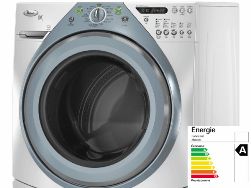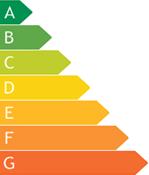Categories: Interesting electrical news, Energy saving
Number of views: 107,118
Comments on the article: 3
Characteristics of energy efficiency classes of household appliances
 Types of household appliances subject to mandatory labeling
Types of household appliances subject to mandatory labeling
Starting January 1, 2011, the household appliances we purchase must have a class designation of energy efficiency. That is, in the passport of the device or on the case, there must be a label of a certain color, with a letter indicating energy efficiency class.
The letter A, on a bright green background, marks the equipment with the highest energy efficiency indicator. Marking B, means lower energy efficiency and is shown on a light green background.
The letters C, D, F, G follow and the color scheme changes from green to yellow (D) to bright red (G), showing the lowest energy efficiency. There are also additional classes A +, A ++, these are devices whose energy efficiency is higher than that of class A.
According to Government Decision No. 1222, the following types of household appliances are subject to mandatory labeling: refrigerators, freezers, washing machines, air conditioners, electric stoves, electric ovens, dishwashers, microwave ovens, televisions, heating electric appliances, electric water heaters, lamps.
So what do these numbers actually mean, and how is this indicator calculated? Let's try to figure it out.
The difficulty is that for various types of household appliances, this indicator consists of different parameters.
 So, for the washing machine, energy efficiency indicator determined by the ratio of power consumption per hour, kW / h, to the maximum load of the machine. The machine consumes 0.8 kW / h when loading 4 kg. Accordingly, the class indicator is 0.8 / 4 = 0.2. This means class B. The range for class A is 0.17-0.19, below that A + begins. Well, if the number exceeds 0.39, such washing machines are the least economical and are marked with G. If your machine has three numbers (AAA, BBB, etc.), do not be alarmed, the first indicates the energy consumption class, the second efficiency class washing, third spin efficiency.
So, for the washing machine, energy efficiency indicator determined by the ratio of power consumption per hour, kW / h, to the maximum load of the machine. The machine consumes 0.8 kW / h when loading 4 kg. Accordingly, the class indicator is 0.8 / 4 = 0.2. This means class B. The range for class A is 0.17-0.19, below that A + begins. Well, if the number exceeds 0.39, such washing machines are the least economical and are marked with G. If your machine has three numbers (AAA, BBB, etc.), do not be alarmed, the first indicates the energy consumption class, the second efficiency class washing, third spin efficiency.
For electric ovens, the class indicator depends on the volume of the oven chamber and power. It distinguishes between small, medium and large ovens. The indicator changes in proportion to the volume: class A, for small volume, 0.6 kW / h, average 0.8 kW / h, large 1.0. Accordingly, G = 1.6, 1.8, 2.0 kW / h and more, for different volumes.
For dishwashers, the calculation is carried out separately to determine the washing efficiency class and drying efficiency class.
The energy efficiency indicator for air conditioners is determined by the ratio of the cold productivity index to the actual energy consumption during cooling.
For refrigerators, the efficiency index is calculated from the ratio of actual electricity consumption to the standard, determined experimentally. For class A, it is 55% and below, and over 125% begins class G.
The energy efficiency class of microwave ovens corresponds to the efficiency of the device.
For televisions, this indicator is the sum of the ratio of power consumption to screen area.
Thus, regardless of the method of finding, the energy consumption index determines the efficiency of your device.
Mandatory designation of the energy efficiency class of household appliances. How does this threaten the consumer?
When choosing household appliances, the consumer pays attention to the price, quality, characteristics declared by the manufacturer, and the trademark. As we have already found out, an important indicator that should be considered when buying any electrical appliance is energy class (energy efficiency class).
 European manufacturers began to indicate the energy efficiency of their products since 1992, when the directive defining the letter designation and color scheme of the energy class was approved. Thus, devices are labeled with an energy sticker, which indicates the energy class, with letters A to G, on the corresponding color background: from green (high energy efficiency) to red (low energy efficiency).
European manufacturers began to indicate the energy efficiency of their products since 1992, when the directive defining the letter designation and color scheme of the energy class was approved. Thus, devices are labeled with an energy sticker, which indicates the energy class, with letters A to G, on the corresponding color background: from green (high energy efficiency) to red (low energy efficiency).
Such products have been present on the Russian market for a long time, but until recently, manufacturers were not required to indicate the class of energy consumption. But, after the adoption of the law on energy consumption in 2009, and the development of decree No. 1222, which lists goods subject to mandatory labeling by the energy consumption class, manufacturers must, from January 1, 2011, indicate the energy efficiency class of the device. Moreover, the class must be confirmed by a specialized, accredited laboratory.
And here is the most interesting. Will all manufacturers be able to confirm the energy class of their products? Plus, such a check is not free. It is highly doubtful that the money spent on confirming the class is compensated by producers or suppliers from their profits. As a result, this will affect the cost of goods, and we will pay, consumers.
This, of course, is unpleasant. However, it is very important to know the energy efficiency of the purchased equipment. After all, this is not just the power consumed by the device, it is an indicator of work efficiency. Only cost a technician with energy class A, will be much more expensive class G.
The choice of class, ultimately, remains with the consumer, I just want the process of designating the class of equipment not to cause a significant increase in the price of goods.
Alexander Melnikov
See also at i.electricianexp.com
:
